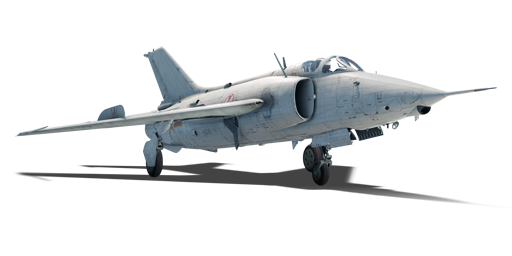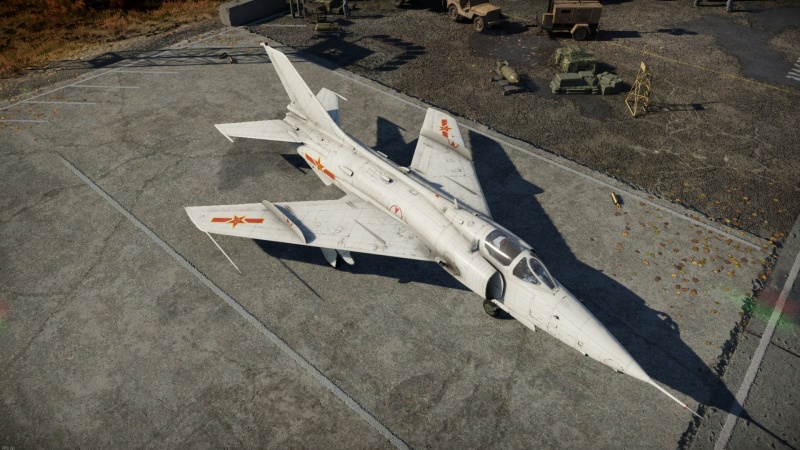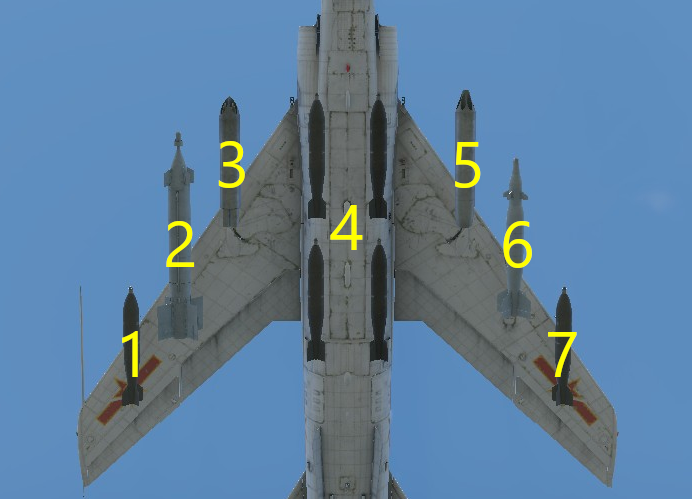Difference between revisions of "Q-5L"
(→Pros and cons) (Tag: Visual edit) |
Colok76286 (talk | contribs) (Edits) |
||
| Line 189: | Line 189: | ||
| || || || 1* || || || | | || || || 1* || || || | ||
|- | |- | ||
| − | | colspan="9" | * The K/PSZ-01 targeting pod must be carried when equipping laser guided bombs | + | | colspan="9" | * The K/PSZ-01 targeting pod must be carried when equipping laser-guided bombs |
|} | |} | ||
| Line 219: | Line 219: | ||
* New HUD with ballistic computer | * New HUD with ballistic computer | ||
* Built-in TVD camera for target acquisition; alternatively equipped with an advanced targeting pod | * Built-in TVD camera for target acquisition; alternatively equipped with an advanced targeting pod | ||
| − | * Access to 250/500 kg laser guided bombs | + | * Access to 250/500 kg laser-guided bombs |
* Sufficient manoeuvrability at around 700 km/h | * Sufficient manoeuvrability at around 700 km/h | ||
* Great acceleration thanks to the WP-6-IIIA engines | * Great acceleration thanks to the WP-6-IIIA engines | ||
Revision as of 10:42, 2 January 2023
| This page is about the Chinese strike aircraft Q-5L. For other versions, see Q-5 (Family). |
Contents
Description
The Q-5L (NATO: Fantan) is a rank VII Chinese strike aircraft with a battle rating of 11.0 (AB), 9.7 (RB), and 10.7 (SB). It was introduced in Update "Fire and Ice".
One of the latest revisions of the Q-5 series in the PLAAF, the Q-5L will prove deadly to ground targets with its sufficient payload and updates to its avionics and new sensors for ground attacks, as well as new precision bombs.
General info
Flight performance
For players who have flown the Q-5 series, Q-5L still retains the same flight performance - although sharing many parts with the J-6A, due to the lack of weight-reduction measures, Q-5s are in fact structurally overweight; while it has better sustained turn to heavier jets such as Phantoms thanks to its engines, do note that the weight issue still haunts the jet. Beware of any targets that have higher manoeuvrability, although your higher speed might save you from subsonic jets, any supersonic jets will have no problem chasing a Q-5L. Another note is that the Q-5L still retains the same control surface lock-up at transonic speeds (>850 km/h and before hitting Mach 1.0), use the airbrakes according to the situation for both regaining control or "snap-shots" on enemy targets.
| Characteristics | Max speed (km/h at 7,000 m) |
Max altitude (metres) |
Turn time (seconds) |
Rate of climb (metres/second) |
Take-off run (metres) | |||
|---|---|---|---|---|---|---|---|---|
| AB | RB | AB | RB | AB | RB | |||
| Stock | 1,434 | 1,430 | 16500 | 25.4 | 25.7 | 139.4 | 129.4 | 850 |
| Upgraded | 1,454 | 1,444 | 24.6 | 25.0 | 186.5 | 162.0 | ||
Details
| Features | |||||
|---|---|---|---|---|---|
| Combat flaps | Take-off flaps | Landing flaps | Air brakes | Arrestor gear | Drogue chute |
| X | ✓ | ✓ | ✓ | X | ✓ |
| Limits | ||||||
|---|---|---|---|---|---|---|
| Wings (km/h) | Gear (km/h) | Flaps (km/h) | Max Static G | |||
| Combat | Take-off | Landing | + | - | ||
| 1,260 | 577 | N/A | 500 | 450 | ~9 | ~5 |
| Optimal velocities (km/h) | |||
|---|---|---|---|
| Ailerons | Rudder | Elevators | Radiator |
| < 540 | < 650 | < 350 | N/A |
Engine performance
| Engine | Aircraft mass | ||||||
|---|---|---|---|---|---|---|---|
| Engine name | Number | Basic mass | Wing loading (full fuel) | ||||
| Shenyang Liming WP-6A-III | 2 | 6,598 kg | 337 kg/m2 | ||||
| Engine characteristics | Mass with fuel (no weapons load) | Max Gross Weight | |||||
| Weight (each) | Type | 10m fuel | 20m fuel | 30m fuel | 34m fuel | ||
| 725 kg | Afterburning axial-flow turbojet | 7,446 kg | 8,215 kg | 9,024 kg | 9,425 kg | 12,457 kg | |
| Maximum engine thrust @ 0 m (RB/SB) | Thrust to weight ratio @ 0 m (WEP) | ||||||
| Condition | 100% | WEP | 10m fuel | 20m fuel | 30m fuel | 34m fuel | MGW |
| Stationary | 2,650 kgf | 3,713 kgf | 1.00 | 0.90 | 0.82 | 0.79 | 0.59 |
| Optimal | 2,677 kgf (1,000 km/h) |
3,789 kgf (1,000 km/h) |
1.02 | 0.92 | 0.84 | 0.80 | 0.61 |
Survivability and armour
- 10 mm steel plate behind nose cone
- 4.5 + 8 mm bulletproof glass in front of the cockpit
- 8 mm steel plate underneath cockpit
- 16 mm steel armoured pilot's seat
- 10 + 25 mm steel armoured pilot's headrest
- Self-sealing fuel tanks behind cockpit and underneath engines in rear fuselage
The Q-5L shares the same protection as its predecessors. Due to the need for ground attack and some protection for the pilot, the cockpit is enclosed by steel plates and comes with bulletproof glass. While this might not be sufficient against any autocannons at the rank, it could at least make sure the pilot will not be knocked out right away by incoming shots or shrapnel. The engines are still unprotected, but the installation of fire suppression systems allows the Q-5L to have greater odds to survive a fire onboard.
Modifications and economy
Armaments
| Ballistic Computer | |||
|---|---|---|---|
| CCIP (Guns) | CCIP (Rockets) | CCIP (Bombs) | CCRP (Bombs) |
| |
|
|
|
Offensive armament
The Q-5L is armed with:
- 2 x 23 mm Type 23-2K cannons, wing-mounted (120 rpg = 240 total)
Suspended armament
The Q-5L can be outfitted with the following ordnance presets:
- Without load
- 28 x Type 90-1 rockets
- 16 x Type 130-2 rockets
- 2 x 260 kg TS250 bombs (520 kg total)
- 2 x 570 kg LS-500J bombs (1,140 kg total)
- 8 x 250 kg 250-3 bombs (2,000 kg total)
- 2 x 500 kg 500-3 bombs (1,000 kg total)
Custom loadout options
| 1 | 2 | 3 | 4 | 5 | 6 | 7 | ||
|---|---|---|---|---|---|---|---|---|
| 250 kg 250-3 bombs | 1 | 1 | 4 | 1 | 1 | |||
| 500 kg 500-3 bombs | 1 | 1 | ||||||
| 260 kg TS250 bombs | 1* | 1* | ||||||
| 570 kg LS-500J bombs | 1* | 1* | ||||||
| Type 90-1 rockets | 7 | 7 | 7 | 7 | ||||
| Type 130-2 rockets | 4 | 4 | 4 | 4 | ||||
| K/PSZ-01 | 1* | |||||||
| * The K/PSZ-01 targeting pod must be carried when equipping laser-guided bombs | ||||||||
The good news for players of the Q-5L is that the PLAAF have finally ditched the -2 series bombs for the streamlined -3 series low-drag bombs, in addition to the ability to carry greater payloads. Players can take eight 250-3 bombs which, combined with the ballistic computer, could do extensive damage to multiple targets. While the option for a pair of 500-3 bombs on the wings also exists, in most cases the 250 kg bombs are more than enough to take down tanks of the rank. Both payloads are also now finally sufficient to (barely) destroy a base in air RB.
Thanks to the technological advances of the early 2000s, the Q-5L also receives "smart bombs" in the 250 kg TS250 and 500 kg LS-500J LGBs. Combined with the K/PSZ-01 targeting pod with excellent thermal sights, both of these bombs can make sure the enemies will have a really bad day while you can keep yourself out of trouble by dropping the bombs from higher altitude.
For players that feel that bombs are not their cup of tea, there are still options for 90 mm and 130 mm rockets at their disposal; while both of them can be guided by ballistic computer as well, do note that they don't have as many salvoes as their NATO/Warsaw Pact counterparts, so aim carefully before firing upon light targets or careless MBTs, taking them out using the high penetration HEAT warheads of the 90-1 or the explosive mass of the 130-2 rockets.
Usage in battles
The Q-5L shares many similar features to previous Fantans: the same bulky MiG-19/J-6-based airframe with high acceleration. While there are some changes to the avionics and weapons, in most scenarios Q-5L flies like all the other Fantans.
Not-so Fighter
An everlasting flaw of the Q-5s is the overweight airframe due to the limits of materials, this still applies to the Q-5L, though it has some parts of the airframe reinforced with modern materials. In most cases, using the Q-5L as a makeshift fighter is not a great idea as the airframe hinders the overall manoeuvrability; yes, it could still surprise in outturning supersonic jets of its rank or sometimes higher, but do remember that the Q-5 is an attacker and doesn't have the manoeuvrability at high speeds, especially at transonic speeds where the control surfaces lock up and might cause trouble when attempting to level out from a dive. To say the least, if enemy fighters are at lower speeds and lack the acceleration to escape from the Q-5L's pair of WP-6III engines, in most cases a sustained turnfight is enough to take them down with ease, assuming the pilot is used to the subpar ballistic performance of 23-2K cannons onboard. In some cases, even jets with delta wings will fall victim to the Q-5L with its superior manoeuvring energy retention. However, only take on enemies when they are on their own, as a prolonged dogfight means that supersonic enemy backup could quickly arrive and turn the tables.
Since the airframe has been reinforced, the Q-5L can carry up to 2 tons of bombs in a single run: for the more dedicated role of being an attacker, taking eight 250-3 bombs are barely sufficient to take down a base at its rank: although this also means you have to land and rearm often, this at least gives the Q-5L a chance to earn extra research points. While bombing AI targets is still viable, only do it when the skies are clear from enemies as the Q-5L lacks countermeasures against enemy missiles.
Payback with Vengeance
While players might not have a good time in aerial combat, the Q-5L brings in a very valuable feature for PLAAF jets: a ballistic computer and guided bombs. To players suffering from enemy jet attackers in ground battles, the Q-5L lets enemies taste their own medicine to some extent. Thanks to the new HUD and sensors onboard, the Q-5L is able to achieve precise strikes with either its bombs or rockets. The new targeting pod onboard provides a thermal vision sight, while the jet itself also has a built-in 1.5x camera for acquisition. For the safest approach against enemy targets, take either the 250/500 kg LGBs (TS250/LS-500J) alongside the targeting pod and climb to at least 6 km before entering the battlefield as this lowers the odds of being pinged by SAM radar and MANPADS of the rank have very little chance of hitting targets at such altitude. Do note that due to the limited view angle of the pod, you might sometimes have to dive in for a better lock, make sure to deploy airbrakes for maximum control.
However, even before any LGBs have been researched, the Q-5L still has a range of unguided ordnance including GP bombs and rocket pods; the ballistic computer onboard can make sure the ordnance lands as close as possible to the designated target. Leave the bombs for (groups of) tanks, and use the rockets against light vehicles or enemy SPAA who aren't aware of your existence.
Pros and cons
Pros:
- New HUD with ballistic computer
- Built-in TVD camera for target acquisition; alternatively equipped with an advanced targeting pod
- Access to 250/500 kg laser-guided bombs
- Sufficient manoeuvrability at around 700 km/h
- Great acceleration thanks to the WP-6-IIIA engines
- Access to RWR
Cons:
- Same bulky airframe as all its predecessors and still locks up at transonic speeds
- The built-in camera only has 1.5x magnification and limited rotation range
- Lacks any type of AAM and countermeasures, unlike its technological predecessor A-5C
- Type 23-2K cannons needs extra practice against aerial targets
- Subpar payload to its NATO/Warsaw Pact counterparts
History
The Q-5L variant of the Q-5 family traces back to two other variants, the Q-5E/F, in the late 1990s.
As part of the efforts to develop domestic precision munitions against enemies' infrastructure inspired by the USAF's AGM-62 and GBU-12 bombs in the Vietnam War and Gulf War, the PLAAF accelerated the development of LGBs in December 1996 with a plan for the precision munitions where either a single jet would carry both the targeting pod and the bombs for an attack run, or it would be guided by another Q-5/ground-based designators; both Factory 612 and 613 in Shaanxi started their respective development on an LGB and the targeting pod. A few brand-new Q-5Ds were then modified into Q-5E and Q-5F as the carrier and designator respectively, where Q-5F would guide the bombs dropped from Q-5E onto the target. Although both jets passed for certification in the early 2000s, it was deemed that 2 separated jets for a run wasn't viable and the project was ditched.
In the mid-1990s, after the previous projects of A-5M and A-5K were canceled by the 1989 Crackdown, the PLAAF requested for a domestic digital upgrade for later batches of Q-5III and Q-5D with new HUD and sensors for precision assaults, as well as as the placeholder before the XAC JH-7 Feibao (NATO: Flounder) entered mass-production. Those jets which were modified from the Q-5III were designated Q-5L with new antennas and stabilized opto-electronic camera in the nose for target acquisition, as well as the capability of carrying the targeting pod on its own for attack runs. With the older avionics replaced with more advanced ones, the new jet entered service in 2005 alongside Q-5Ns that were modified from the Q-5D and served as the economical alternatives to new jets before they were eventually replaced by fighters with multirole features such as J-10A, Feibao, and Flankers in 2017. [1]
Media
- Videos
See also
- Q-5 early- LRIP of Q-5
- Q-5A- Base model of Q-5s
- A-5C- Export model of Q-5 and the technological predecessor of Q-5L
External links
References
- ↑ PP.77-82, The Rising East Wind- The Biography of Q-5 Attacker by Lao Bi and Liu Ming, NAAS & Inertial Technology, ISSN 1009-5497, 2014
| China jet aircraft | |
|---|---|
| Fighters | J-2 · J-4 · J-6A · J-7II · J-7D · J-7E · J-8B · J-8F · J-10A · J-11 · J-11A |
| Strike aircraft | Q-5 early · Q-5A · Q-5L · JH-7A |
| Bombers | H-5 |
| France | ␗Mirage 2000-5Ei |
| USA | ␗F-84G-21-RE · ␗F-84G-31-RE · ␗F-86F-30 · ␗F-86F-40 · ␗F-100A · ␗F-100F · ␗F-104A · ␗F-104G · ␗F-5A · ␗F-5E · ␗F-16A MLU |
| USSR | ␗MiG-9 · ␗MiG-9 (l) |
| North Korea | Shenyang F-5 |
| Pakistan | A-5C · JF-17 |






